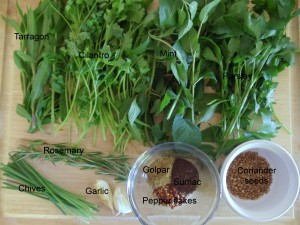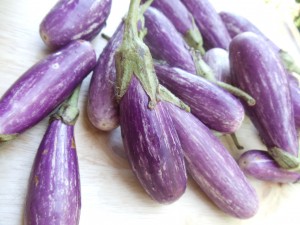Aug 02 2012
Torshi e Bademjan
Years ago, my sister Brigitte was married to an Iranian man. She met him in Paris, where he still lives, but most of his family lived in Tehran. These were the early days of the Islamic Revolution, and they certainly were not very good times for Ali’s family, yet a few of them somehow managed to get in and out of the country for annual trips to Paris. I was only a teenager at the time, but I do remember those visits from some of Ali’s siblings, as they were always a time for some exotic fun. They always brought with them some goodies from back home, such as large bags of pistachios, the occasional jar of caviar (the best I’ve had to date), and some homemade pickled eggplants. The latter were a particular favorite of my mother’s, who would have to exercise great restraint in order not to eat an entire container in one sitting.
Torshi, as pickles are called in Farsi, are meant to be eaten alongside a meal, much as Indian chutneys or French cornichons are, and their tangy goodness is a great complement to many dishes. They can be made with a variety of vegetables. Brigitte is very fond of garlic pickles (seer torshi), which can and should be kept for many years, as they only keep getting better as time passes. She recently told me she had tasted some that was over twenty years old, and that it was truly delectable. As she says, if we make some now, we could enjoy it in retirement. How’s that for meal planning? I’m tempted, actually.
To make today’s torshi, choose very small bademjan (eggplants), such as fairytale eggplants, or baby purple ones. The few recipes I’ve seen out there call for dried herbs, but Ali’s mother’s recipe uses fresh herbs, and there’s absolutely no doubt in my mind that they are what makes this condiment so special. So if you go ahead and make this – as I hope you will, because it’s really dynamite – don’t take any shortcuts; you would deprive yourself needlessly. The hardest spices to procure are golpar (ground angelica) and sumac, but fortunately, we live in an Internet age where nothing’s impossible; and once you have those in your spice pantry, you can use them for other easy to prepare, middle eastern dishes. Sumac is delicious sprinkled on plain white rice.
My sister gave me her recipe in a typical French way, which is to say without any quantities. She and many other French cooks do things this way, “au feeling,” which is a wonderful non-method that requires using your better judgment. In France, people will often tell you things like “n’en mets pas trop” (don’t put too much) or “tu vois bien” (see?), which assumes that the listener has enough knowledge and/or experience to figure out on his or her own how much is enough. I know that my American friends tend to be somewhat intimidated by this, and so I share this recipe with you with some additional details. Please feel free to use your own instincts (as I did) as you go along. This is a good place to try, as the recipe is quite forgiving and nothing can go terribly wrong.
Nush-e jan!
Torshi e Bademjan
Pickled Eggplants
1 lb baby or fairytale eggplants, green top trimmed
1 qt apple cider vinegar
1/4 cup each tarragon, mint, cilantro, parsley – finely chopped
1 Tbs each chopped rosemary and chives
2 or 3 cloves garlic, minced
1 tsp each sumac and golpar
1/2 tsp red pepper flakes
2 tsp coriander seeds
1 tsp fleur de sel (or sea salt)
Bring vinegar to a boil, and simmer whole eggplants in it for 5 min. Turn off heat, remove eggplants and set vinegar aside. Let cool. Meanwhile, chop and combine herbs, garlic, and spices (except coriander seeds) together in a bowl. Make a deep slit along the length of the cooled eggplants, and stuff with herb mixture. Place in a container, cover with vinegar, sprinkle with coriander seeds and salt, and close container. Refrigerate. They will be ready to eat in about 2 months or so. The longer you wait, the better!

They already look good. Now they're ready to be covered in vinegar and put in the fridge for a 2-month nap.
Serve as a condiment alongside kebabs and rice, or any middle eastern dish.



